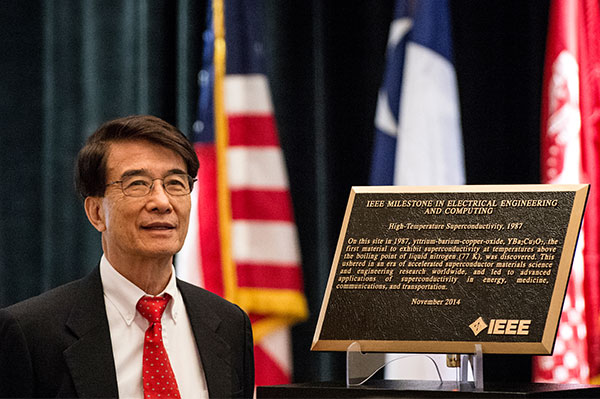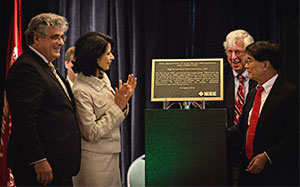
IEEE Milestone Award Marks Site of Discovery of High Temperature Superconductivity

Achievement Led to Applications in Energy, Medicine, Communications and Transportation
The University of Houston was recognized by IEEE (the Institute of Electrical and Electronics Engineers) as the site of the discovery by physicist Paul Chu and colleagues of a material that made high temperature superconductivity practical for real-world applications. The IEEE’s prestigious Milestone Award in Electrical Engineering and Computing was presented to UH on November 17.
In 1987, Chu and his team found and identified that yttrium-barium-copper-oxide, or Y-123, exhibits superconductivity at temperatures above the boiling point of liquid nitrogen. The material was able to conduct electricity without any loss due to resistance at above 77 degrees Kelvin, allowing it to be cooled with liquid nitrogen, which dramatically reduced the cost.
“It was extremely gratifying to receive such an honor to recognize our achievement,” said Paul Chu, TLL Temple Chair of Science, professor of physics and founding director and chief scientist of the Texas Center for Superconductivity at UH.
Chu’s team in 1987 included four graduate students, three undergraduate students and two visiting scholars in Houston and M.K. Wu’s group of two students in Huntsville, Alabama.
Real-World Applications
The bronze IEEE plaque noted the discovery “ushered in an era of accelerated superconductor materials science and engineering research worldwide, and led to advanced applications of superconductivity in energy, medicine, communications and transportation.” Superconductivity applications include its use in magnetic resonance imaging machines, electric motors, sensors in satellites and new high-speed trains.
 The plaque was unveiled during dedication events that featured a luncheon and community lectures addressing the history, physics and future applications of superconductors. Speakers included Chu, 2003 Nobel Prize winner Sir Anthony J. Leggett, and Alan Lauder, executive director of the Coalition for the Commercial Application of Superconductors.
The plaque was unveiled during dedication events that featured a luncheon and community lectures addressing the history, physics and future applications of superconductors. Speakers included Chu, 2003 Nobel Prize winner Sir Anthony J. Leggett, and Alan Lauder, executive director of the Coalition for the Commercial Application of Superconductors.
The IEEE Milestone plaque is permanently located in the lobby of the College of Natural Sciences and Mathematics’ Science and Research Building 1. The discovery occurred in a lab on the 4th floor.
The Milestones program honors significant technical achievements that are considered momentous breakthroughs. The award to UH was coordinated by the IEEE Houston Section and the IEEE Council on Superconductivity.
Second Milestone in Superconductivity
This is the second IEEE Milestone to be awarded in superconductivity. The first was dedicated in 2011 to celebrate the centennial of the discovery of superconductivity in 1911 by Haike Kammerlingh Onnes at the Leiden Laboratory in The Netherlands.
“It is fitting that this second Milestone was dedicated in Houston after a shorter invention-to-Milestone timespan, highlighting both its fundamental and technological relevance,” said Elie Track, president of the IEEE Council on Superconductivity.
More than 100 Milestones have been approved and dedicated around the world in the past 31 years; this is the first Milestone in the Houston region.
IEEE, the world’s largest technical and professional association, includes engineers, scientists and allied professionals, including computer scientists, software developers, physicists, medical doctors and others, in addition to electrical and electronics engineers.
Jeannie Kever, University Media Relations, and Kathy Major, College of Natural Sciences and Mathematics